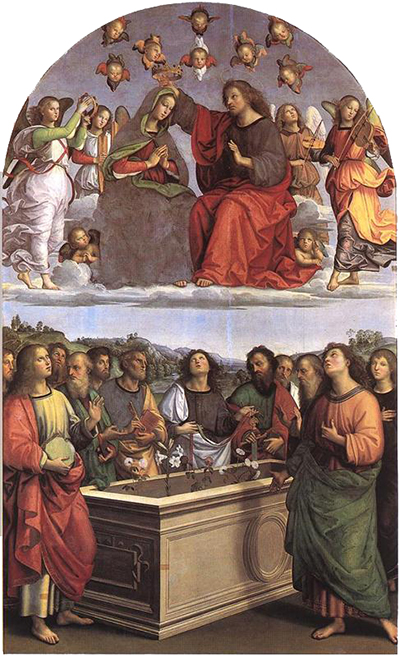The Crowning of the virgin is an altarpiece painted by Raphael in 1502 to 1504. It was painted for the altar of the Oddi family chapel in the famous church of San Francesco al Prato located in Perugia.
In the year 1797, the painting was confiscated by the French before transferring it to Paris and bringing it back to Italy in the year 1815. The painting was commissioned for the Oddi family in San Francesco al Prato. The main actions of Raphael's work occur in two related sites, one in terrestrial and the other in heaven. Just above the coronation, the virgin has been crowned while the angels are playing their musical instruments. The bottom section of the painting shows the apostles gathering around an empty tomb of Mary. In the painting, St Thomas holds the girdle Mary in his hands after dropping down to him as the statement of her assumption. All the saints raise their eyes to a heavenly spectacle.
It is difficult to separate the painting style of Raphael from that of Perugino who was his master. It is true that his young hands must have played an essential role in most of Perugino’s main commissions. Also, his debt to the master, Perugino is evident when you compare the marriage of the virgin to Perugino’s work when Christ was handing the keys to St Peter.
You can easily identify the same array of the foreground figures in the Crowning of the Virgin painting, the same intervening piazza and the same polygonal of the background temple. Even the main colours such as the deep blue, cloudless blue sky, the yellows and roses, and the blue-green of hills are derived from his master, Perugino. Despite the painting similarities, however, his work is different from Perugino in space and form. Also, his graceful figures in his work are woven into a unity that is not known in his master's art.
His early artistic and painting career coincided with the utilization of oil paint in Italy. If you look at most of Raphael’s artistic work on the panel, they all seem to use oil. He also used egg tempera in the earliest offerings. When he relocated to Rome, all of his artistic work was designed and created entirely in oil. Most of his work was on a piece of paper and sometimes on vellum. The medium he used in his artistic work was a type of gouache that was bound in animal glue.
The altarpiece brings together two scenes or sites common in Quattrocento iconography. The two essential scenes are the giving of the girdle to Saint Thomas that is represented in the lower section and the Crowning of the virgin that occupies the upper section of the painting. The two main scenes remain separated from each other which is a clear division of the painting composition and uncertainty. Also, the forms in the painting are already mature, and specific innovations in perspective like the diagonal appearance and representation of the tomb constitute a departure from the traditional Quattrocento compositional types.




